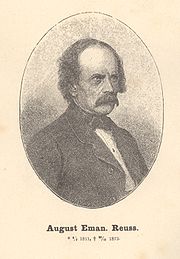
August Emanuel von Reuss
Encyclopedia

August Emanuel von Reuss (1811–1873), Austria
Austria
Austria , officially the Republic of Austria , is a landlocked country of roughly 8.4 million people in Central Europe. It is bordered by the Czech Republic and Germany to the north, Slovakia and Hungary to the east, Slovenia and Italy to the south, and Switzerland and Liechtenstein to the...
n geologist
Geologist
A geologist is a scientist who studies the solid and liquid matter that constitutes the Earth as well as the processes and history that has shaped it. Geologists usually engage in studying geology. Geologists, studying more of an applied science than a theoretical one, must approach Geology using...
and palaeontologist, was born at Bílina
Bílina
Bílina is a town in the Teplice District in the Ústí nad Labem Region of the Czech Republic. It is located on the river Bílina. It is known for its comforting and relaxing spas.-Location:...
in Bohemia
Bohemia
Bohemia is a historical region in central Europe, occupying the western two-thirds of the traditional Czech Lands. It is located in the contemporary Czech Republic with its capital in Prague...
on 8 July 1811, the son of Franz Ambrosius Reuss (1761–1830). He was educated for the medical profession, graduating in 1834 at the University of Prague
Charles University in Prague
Charles University in Prague is the oldest and largest university in the Czech Republic. Founded in 1348, it was the first university in Central Europe and is also considered the earliest German university...
, and afterwards practising for fifteen years at Bílina.
His leisure was devoted to mineralogy
Mineralogy
Mineralogy is the study of chemistry, crystal structure, and physical properties of minerals. Specific studies within mineralogy include the processes of mineral origin and formation, classification of minerals, their geographical distribution, as well as their utilization.-History:Early writing...
and geology
Geology
Geology is the science comprising the study of solid Earth, the rocks of which it is composed, and the processes by which it evolves. Geology gives insight into the history of the Earth, as it provides the primary evidence for plate tectonics, the evolutionary history of life, and past climates...
, and the results of his researches were published in (1840–1844) and (1845–1846). In 1849 he gave up his medical practice, and became professor of mineralogy at the university of Prague. There he established a fine mineralogical collection, and he became the first lecturer on geology.
In 1863 he was appointed professor of mineralogy in the University of Vienna
University of Vienna
The University of Vienna is a public university located in Vienna, Austria. It was founded by Duke Rudolph IV in 1365 and is the oldest university in the German-speaking world...
. He investigated the Cretaceous
Cretaceous
The Cretaceous , derived from the Latin "creta" , usually abbreviated K for its German translation Kreide , is a geologic period and system from circa to million years ago. In the geologic timescale, the Cretaceous follows the Jurassic period and is followed by the Paleogene period of the...
fauna of Gosau
Gosau
Gosau is a municipality in the district of Gmunden in Upper Austria, Austria.- Location and General Information :Gosau is situated along the Gosaubach stream in the Salzkammergut region. The center of the town is at an elevation of 767...
, and studied the Crustacea
Crustacean
Crustaceans form a very large group of arthropods, usually treated as a subphylum, which includes such familiar animals as crabs, lobsters, crayfish, shrimp, krill and barnacles. The 50,000 described species range in size from Stygotantulus stocki at , to the Japanese spider crab with a leg span...
, including Entomostraca
Entomostraca
Entomostraca is a historical subclass of Crustacea, no longer in technical use. It was originally considered one of the two major lineages of crustaceans , combining all other classes – Branchiopoda, Cephalocarida, Ostracoda and Maxillopoda. The Ostracoda have the body enclosed in a bivalve...
, the coral
Coral
Corals are marine animals in class Anthozoa of phylum Cnidaria typically living in compact colonies of many identical individual "polyps". The group includes the important reef builders that inhabit tropical oceans and secrete calcium carbonate to form a hard skeleton.A coral "head" is a colony of...
s, bryozoa
Bryozoa
The Bryozoa, also known as Ectoprocta or commonly as moss animals, are a phylum of aquatic invertebrate animals. Typically about long, they are filter feeders that sieve food particles out of the water using a retractable lophophore, a "crown" of tentacles lined with cilia...
, and especially the Foraminifera
Foraminifera
The Foraminifera , or forams for short, are a large group of amoeboid protists which are among the commonest plankton species. They have reticulating pseudopods, fine strands of cytoplasm that branch and merge to form a dynamic net...
of various geological formations and countries. He died at Vienna
Vienna
Vienna is the capital and largest city of the Republic of Austria and one of the nine states of Austria. Vienna is Austria's primary city, with a population of about 1.723 million , and is by far the largest city in Austria, as well as its cultural, economic, and political centre...
on the 26 November 1873.

